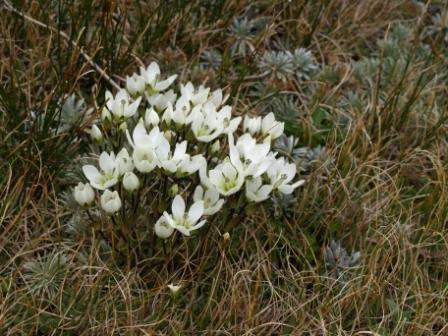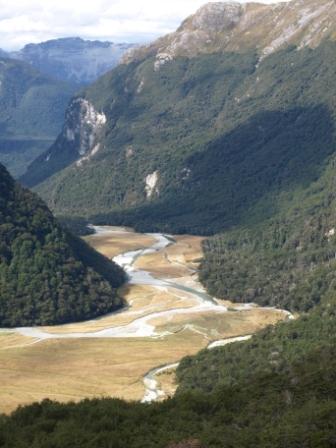Tramping

VulcanSpirit
Richard & Alison Brunstrom
Mon 6 May 2013 10:31
|
Kiwis (New Zealanders actually so refer to
themselves; but absolutely not to be confused with Chinese gooseberries, which
here MUST be called kiwi fruit to avoid offence) call backpacking
'tramping'; I know not why. Tramping is big here, usually utilising
DoC's excellent hut network rather than camping. Kiwis aren't as
roughtie-toughtie as they would have you to believe, it seems.
Tourism is now NZ's biggest foreign currency
earner, bigger than agriculture, and the government and DoC are just brilliant
at marketing their great outdoors. Part of this effort is the establishment of a
number of multi-day "Great Walks". I went to the south of South Island to do one
of them, the Routeburn. This starts near Glen Orchy in the Queenstown area and
goes across a pass into the Fiordland National Park. The track is only 32km long
but by road the journey is about 190km making one way trips a logistical problem
so I walked a circular route taking four-five days with two American yachtie
friends, Jon and Heather Turgeon, seen below as we climb up from Lake
Mackenzie (both are extreme runners, doing mountain marathons for fun;
thankfully they move more slowly when backpacking):
 Jon at the top of the first pass (McKellar 'saddle'
in Kiwispeak), Mount Crosscut (2230 metres) in the background. The trees
are Southern Beech (Nothofagus spp), fairly closely related to the
European Beech but with a distinctive growth pattern giving rise to the weird
forests seen in the Hobbit films made here.
 Camping. No wishy-washy huts for us. My tent is the
orange one:
 Looking west over the Hollyford Valley towards the
Southern Alps and Fiordland. This part of the walk is a 5km traverse at
well over 1000 metres with wonderful views:
 On the way down towards the Routeburn Valley in the
left distance, Lake Harris in the foreground at 1225m. This is above the natural
treeline and is amazingly like Snowdonia in North Wales, albeit at greater
altitude. These mountains are very young indeed in geological terms. Until less
than 5m years ago NZ was a country of low relief. Since then the land here has
been rising at about 10mm a year; this may not seem like much until you start
multiplying by the millions required by geological time. In fact the
mountains have risen in excess of 20km (!)
but erosion has been about the same rate so the summits are maintaining a
fairly stable altitude.
 The young mountains have rapidly acquired their own
alpine flora. Here are a couple of them. The first is the NZ Common Gentian
Gentianella bellidifolia. As usual in NZ the native gentians here are
white, possibly because the pollinating insects like white flowers
(although this seems too simple an explanation to me)
 And this is the Large Mountain Daisy Celmisia
semicordata (I think - NZ has lots & lots of daisies, over 60 species
in the genus Celmisia alone, all looking much the same), here
growing in typical mountain habitat of bare rock and sand near the top of
Conical Hill at 1515m.
 As a digression, here is a famous NZ flower of the
Southern Alps, the very large Mount Cook Lily (recognisably a
buttercup) Ranunculus lyallii:
 I actually took this near Mount Cook in December
but I've put in in again here because I've subsequently learned something
interesting about it. The clue is in the Latin name, Ranunculus. This
is a European genus, several species of which are adapted for a montane life.
But there were no mountains in NZ until recently. The plant is known (from
pollen records) to have been here before humans arrived 850 years ago - so its
ancestors must have got here from Europe after the mountains rose but
before humans could have transported it. Quite a feat for a
buttercup.
Back to the tramp. Here is the valley of the Route
Burn looking downstream, east towards Glen Orchy. The natural treeline is very
obvious on the right, as if set out with a ruler, and the flat valley floor
is almost archetypal of a glaciated valley. The tussock grass here would for
millions of years have been grazed by flocks of moa, but sadly no
more.
 A very splendid walk, but to my mind the
Southern Alps are not as impressive as their European counterparts. On the other
hand they are relatively untouched by human activity - no restaurants, no cable
cars, no railways, no cars, no towns to spoil the natural grandeur.
|